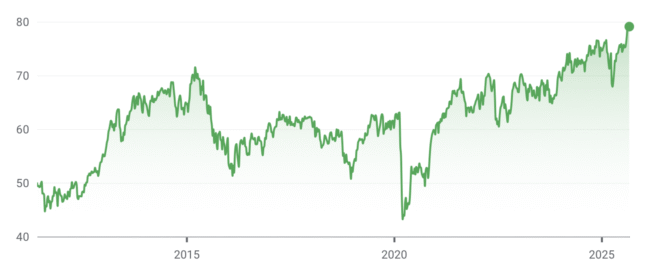The data drops we’ve seen in recent weeks has me thinking that we’re potentially facing a stock sell-off. So, the question is this: Do I want to take some profit and make my portfolio more defensive? However, this means I could be turning my back on any Trump-created upside for stocks between now and 2026.
If you want to be a real ‘risk averse’ investor and simply chase the best term deposit rates, then the likes of Judo Bank is offering 4.35% for a five-month period. After that, rates will probably head lower, which means you have to be careful of a ‘nice rates now’ offer that converts to a lower rate in the near future.
For example, Macquarie’s 4.6% rate lasts for 4 months on your first account up to $250,000. After that, it converts to a variable rate of 4.25%. NOTE: it’s variable! If rates fall, so will the rate of interest paid out. While the ING offer looks good, you have to be aware of the fine print. As the advertisement says:
Up to: 4.8% p.a. variable with bonus interest on balances up to $100k. ING Savings Maximiser:
Earn bonus interest when you also hold an Orange Everyday account and each month meet the eligibility criteria and grow your nominated Savings Maximiser Balance (excluding interest)
Did I warn you to know what’s in the fine print?
According to money.com.au, the best one-year rate was from the Great Southern Bank, which was 4.1%. While Heartland Bank has the same rate, conditions are slightly different.
I didn’t find a big four bank term deposit, until I got to the Westpac offering of 3.55%. It does pay to shop around. If you want slightly higher returns (but you’ll have to add in risk), you can look at bond funds that should deliver around 5%. That said, these funds can shock you at times if international interest rates behave in an unexpected way.
If you want 6%, the well-known and good-performing La Trobe has a 12-month account. But this isn’t a government-guaranteed product, which is something you must remember. While historically these guys have been good, they could be vulnerable if the age of Trump creates an unusual market slump. They don’t have the government protection that $250,000 term deposits with a local bank have.
My preferred defensive play is to swap more growth-oriented investments for those that pay good income. This means I still access the upside from a stock market that defies recent worrying data drops (such as slightly higher inflation and a weakening labour market in the US) but if shares do drop significantly, I still get a nice dividend plus franking credits.
It does mean I could see my recent profits from the bull market that probably started in April 2020 (or even February 2016, depending on whether you want to call the Coronavirus sell-off and quick rebound as an aberration).
S&P/ASX 200

When fool.com recently looked at bull markets history, this is what it found:
“The good news is that, on average, bull markets tend to outlast bear markets. The average S&P 500 bull market between 1929 and 2023 has lasted 1,011 days, according to data from Bespoke Investment Group, while the average bear market has done on for around 286 days. More recent bull markets are also lasting longer. Three of the last 10 bull markets have gone on for at least 2,000 days, with eight lasting for more than 500 days. Among the 10 earliest bull markets starting in 1929, though, only two lasted longer than 200 days.
So, using the 1,011 day figure, this current bull market has lasted a long time. As the 2009 to 2020 bull market lasted around 4,000 days, history on this subject isn’t conclusive.
Anyone looking for stocks that are good income-payers, should look at Paul Rickard’s collection in his income portfolio. This table shows what stocks he holds. The return has been 12.17% over eight months, with income up 2.6%, which annualises at 3.9% before franking credits kick in.
Meanwhile, income-oriented ETFs such as Vanguard’s High Yield (VHY) fund have been good performers. And the likes of Beta Shares, State Street and others have similar products that could be reasonable products to swap with high growth stocks that you want to take profit with.
However, remember this: with income funds, while their unit price will fall with the market, the losses will be offset by the income and franking credits that they deliver.
While I’d love to crow about the Switzer Dividend Growth fund, others have outperformed, though this table does show it has returned around 5% on average, which might look good as term deposit rates fall, and stock prices slip.

Here’s one final point needs to be made.
When you invest in stocks or funds that buy stocks, you must remember that bull markets historically last longer than bear markets. On average, the bull-to-bear market ratio in terms of how long is nearly 5:1.
Provided you buy good defensive stocks or funds that pay good income, then as stock markets slide, you should have the courage and wherewithal to dollar-cost average, as these sorts of stocks and funds are good rebounders out of share market crashes. These two charts of CBA and VHY show that.
CBA

VHY

The bottom line is that if you’re not a scaredy cat who has to protect their capital at all cost, then you simply commit to good assets that pay income in good and bad times. And then you need to simply understand that to get the good returns over seven or eight years out of ten, you must grin and bear it in the two or three bad years that could come along.
If you’re wise enough to dollar-cost-average, you will make money in a market crash by buying the dip and then being patient.
Of course, if you have the need to spend about $100,000 a year, you could pull out $300,000 and put it into term deposits and higher income cash accounts. This could ensure you have plenty of cash during those rough times. And you might use some of it to buy great stocks at post-crash prices.
Remember, CBA was $57.66 on 27 March 2020, which was the bottom of the Coronavirus Crash. If you bought CBA then, you’re now up 191% on one of the best banks and stocks in the world! Crashes aren’t all bad for your wealth, as long as you play it smart!

